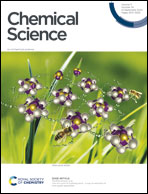Conformation control through concurrent N–H⋯S and N–H⋯O![[double bond, length as m-dash]](https://www.rsc.org/images/entities/char_e001.gif) C hydrogen bonding and hyperconjugation effects†
C hydrogen bonding and hyperconjugation effects†
Abstract
In addition to the classical N–H⋯O![[double bond, length as m-dash]](https://www.rsc.org/images/entities/char_e001.gif) C non-covalent interaction, less conventional types of hydrogen bonding, such as N–H⋯S, may play a key role in determining the molecular structure. In this work, using theoretical calculations in combination with spectroscopic analysis in both gas phase and solution phase, we demonstrate that both these H-bonding modes exist simultaneously in low-energy conformers of capped derivatives of Attc, a thietane α-amino acid. 6-Membered ring inter-residue N–H⋯S interactions (C6γ), assisted by hyperconjugation between the thietane ring and the backbone, combine with 5-membered ring intra-residue backbone N–H⋯O
C non-covalent interaction, less conventional types of hydrogen bonding, such as N–H⋯S, may play a key role in determining the molecular structure. In this work, using theoretical calculations in combination with spectroscopic analysis in both gas phase and solution phase, we demonstrate that both these H-bonding modes exist simultaneously in low-energy conformers of capped derivatives of Attc, a thietane α-amino acid. 6-Membered ring inter-residue N–H⋯S interactions (C6γ), assisted by hyperconjugation between the thietane ring and the backbone, combine with 5-membered ring intra-residue backbone N–H⋯O![[double bond, length as m-dash]](https://www.rsc.org/images/entities/char_e001.gif) C interactions (C5) to provide a C5–C6γ feature that stabilizes a planar geometry in the monomer unit. Two contiguous C5–C6γ features in the planar dimer implicate an unprecedented three-centre H-bond of the type C
C interactions (C5) to provide a C5–C6γ feature that stabilizes a planar geometry in the monomer unit. Two contiguous C5–C6γ features in the planar dimer implicate an unprecedented three-centre H-bond of the type C![[double bond, length as m-dash]](https://www.rsc.org/images/entities/char_e001.gif) O⋯H(N)⋯SR2, while the trimer adopts two C5–C6γ features separated by a Ramachandran α-type backbone configuration. These low-energy conformers are fully characterized in the gas phase and support is presented for their existence in solution state.
O⋯H(N)⋯SR2, while the trimer adopts two C5–C6γ features separated by a Ramachandran α-type backbone configuration. These low-energy conformers are fully characterized in the gas phase and support is presented for their existence in solution state.
![Graphical abstract: Conformation control through concurrent N–H⋯S and N–H⋯O [[double bond, length as m-dash]] C hydrogen bonding and hyperconjugation effects](/en/Image/Get?imageInfo.ImageType=GA&imageInfo.ImageIdentifier.ManuscriptID=D0SC03339A&imageInfo.ImageIdentifier.Year=2020)


 Please wait while we load your content...
Please wait while we load your content...
![[double bond, length as m-dash]](https://www.rsc.org/images/entities/h2_char_e001.gif) C hydrogen bonding and hyperconjugation effects
C hydrogen bonding and hyperconjugation effects